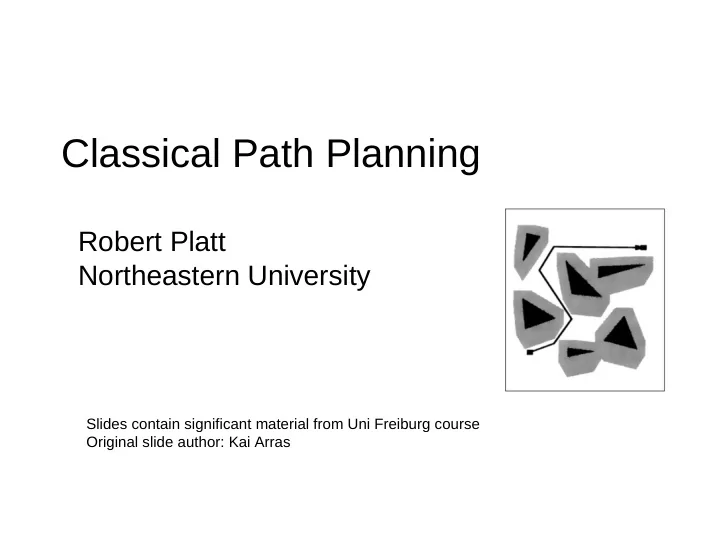

Classical Path Planning Robert Platt Northeastern University Slides contain significant material from Uni Freiburg course Original slide author: Kai Arras
Problem we want to solve Given: – a point-robot (robot is a point in space) – description of obstacle space and free space – a start configuration and goal region Find: – a collision-free path from start to goal workspace configuration space
Problem we want to solve Given: – configuration space – free space – start state – goal region Find: – a collision-free path , such that and workspace configuration space
Problem we want to solve
Method #1: Visibility Graphs n = num of obstacle vertices
Question Can you think of an n^3 algorithm to compute the visibility graph?
Method #2: Generalized Voronoi Diagram
Method #2: Generalized Voronoi Diagram
Question How many regions in a voronoi diagram with n objects?
Method #2: Generalized Voronoi Diagram
Method #3: Exact Cell Decomposition
Method #3: Exact Cell Decomposition
Question Do you need the vertices at the center of the trapezoids? Why/Why not?
Method #4: Uniform Approximate Cell Decomposition c Uniform cell shape: e.g. wavefront planner
Method #5: Quadtrees Non-Uniform cell shape: e.g. quadtree decomposition
Method #5: Quadtrees define G = Decompose(G,resolution): Collision-check: check whether 1. if G null: each cell is completely free or not 2. create coarse grid 3. collision-check G 4. for all occupied cells c in G: 5. delete c from G 6. subdivide c into four cells (sub) 7. add sub into G 8. collision-check sub define FindPath(maxresolution): 1. for resolution = coarse to maxresolution: 2. G = Decompose(G,resolution) 3. if Check-for-path(G) == True: 4. Success! Why do you think this method is called “quadtree”?
Method #5: Octomaps Same as quadtrees, but in three dimensions...
Examples of solutions found using octomaps
Exact vs approximate cell decomposition
Method #6: Potential Functions
Method #6: Potential Functions
Method #6: Potential Functions
Method #6: Potential Functions After computing U, follow the negative gradient:
Potential Function Limitations
Potential Function Limitations
Applications to manipulators Compute potential function in Cartesian space: Project into joint space: Compute goal velocities at different points on the arm: x d Pull eff toward goal and obstacle away from obstacles x 2 Push x1 and x2 away x 1 from obstacles 0 z
Applications to manipulators Can you draw a bug-trap-like scenario where this approach won’t work? x d obstacle x 2 x 1 0 z
Recommend
More recommend